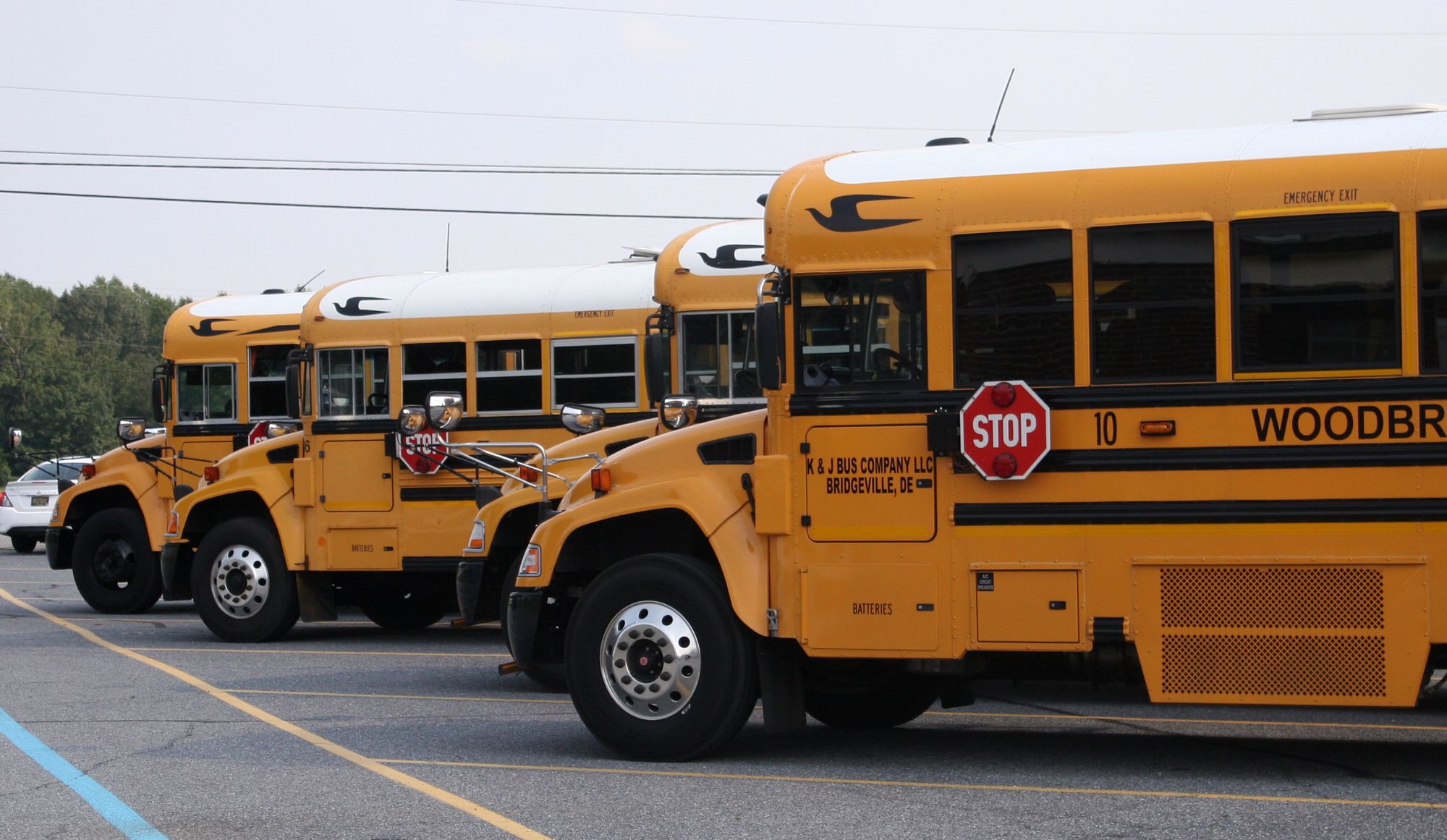Why there’s a bus driver shortage, and possible ways to fix it

The kids are back in school — but getting them to and from the building has been a headache, just as the prophecies this summer foretold.
It’s a problem years in the making and a lot of issues converged to make it the huge headache it is now, industry insiders say. That may make it tricky to solve.
One local bus contractor thinks he has a pretty good idea where to start, though: More money for drivers.
The hourly rate for bus drivers hasn’t changed much in years, said Bob Koppenhaver of RJK Transportation, a bus contractor serving the Milford School District who has been in the business almost 40 years.
The state has a complex formula for paying bus contractors that’s been around since the 70s, and considers fuel costs, mileage, maintenance and driver pay, among other factors. Once he’s taken out other costs, what’s left for driver pay is just under $16 an hour, Koppenhaver said.
“That’s a bigger issue, especially when retail service jobs are now offering what we’re being given to give the drivers, per hour,” he said.
Lake Forest is among the many Delaware districts being affected by the shortage. Dustin Weller, transportation supervisor there, said last week the district has 51 buses under contract, and they are down six drivers.
“We’ve been able to absorb it so far,” he said, but eventually “it could become a very stressful situation as far as the crowding of buses.”
Parents have noticed already.
“As a parent of 3 children who ride buses, I’ve noticed they are taking longer to come home,” one parent wrote in a local Facebook group for western Sussex County. “My oldest son’s school even emailed us and told us they are running full buses and that even some children will probably have to sit 3 to a seat.”
A local bus driver backed that up, saying her contractor lost several drivers right before school started, and they are indeed having to put three children to a seat. She finds that alarming, given the need for social distancing and the way small children don’t keep their masks up. The driver said she now has COVID.
Support our local news coverage: Subscribe to the Delaware Independent

How did we get here?
Those who have been following such things since before they became national news agree that the bus driver shortage predates the pandemic.
In a 2018 article addressing the issue, School Transportation News fretted, “All indications are that the situation has worsened.”
In 2019, an Indiana school district even offered teachers $18,000 to take on bus driving as a second job, the Indianapolis Star reported, saying the district had struggled for years to find drivers. Teachers were surely thrilled to finally find something to do with their time.
Multiple people we spoke to for this article, from bus contractors to state employees, mentioned the heavy responsibilities bus drivers face, the steep requirements for qualifying as a driver, and the fact that they can get better pay in similar jobs elsewhere — all that, in addition to the fact that employers in general are now struggling to find workers and many bus drivers are older people who are concerned about the risks from COVID.
“Employers in many sectors are competing for a limited workforce,” Alison May, a spokesperson for the Delaware Department of Education, said in an email. “Some of these jobs require fewer skills, less stress and offer more flexible hours than driving a school bus.”
Here are some of the issues that have been stacking up. Hold tight, there are a lot of them.
The hours
School bus drivers work part time hours, so even if their hourly wage were higher they could get more money elsewhere. Koppenhaver said contractors even lose drivers to school districts that hire their own drivers and can offer them benefits and extra work during the day, say, in the cafeteria.
Working only part time can be a draw for retirees or others looking for some extra income, of course. But many of those people are older, which means there’s ...
The fear of COVID
“The pandemic has affected the employee pool, particularly because many former/current/potential drivers fall in a higher risk category due to their age,” the DOE’s May wrote.
“We have a lot of drivers who are semi-retired,” Koppenhaver said. Some of them have decided that with the risk factors like being around kids in an enclosed area, they just don’t feel comfortable continuing driving or becoming a bus driver in the first place.
There’s a ray of hope there, however. Weller said when the pandemic eases, more people might be ready to get out and enter the workforce again.
Even for people who may not be as worried about COVID, though, there’s …
The training
It takes two to three months from start to finish to get a driver trained, said Regina Warnick, a bus contractor for the Woodbridge School District, which has also felt the impact of the shortage. And all that training is for a low paying job with a tremendous amount of responsibility, she said, noting that once she trains a driver they can go get another job driving a dump truck or a trash truck.
Koppenhaver put the average time for training at about six to eight weeks. “If somebody comes through with a (commercial driver’s license), then the process can be expedited. But most people that have CDLs, you know, have other opportunities too ... or a full time job with benefits.” And once they do qualify, he said, some of his drivers have left for other jobs.
“I think the training portion of it sometimes is challenging and is very cumbersome for people,” Weller said. If there’s any way to streamline the training process and make it more user friendly for new drivers, “that would definitely be a big help.”
But before training can start, there have to be applicants. Koppenhaver said one area contractor he knows is so short on drivers, he’s had to park five of his buses. But nobody is applying for the positions.
Which brings us to …
The job market
All over the state, some businesses, especially restaurants, have been struggling to attract workers. In one local example, a sign on Emma’s Family Restaurant in Greenwood recently warned customers that the restaurant would not be open as many hours as usual. A waitress explained that they were short staffed and having trouble finding anyone to fill the spots.
Earlier this year, the National School Transportation Association blamed, in part, extra unemployment benefits for reducing people’s motivation to work and contributing to the driver shortage. (This idea is a disputed one, with some economists pointing to other factors.)
Koppenhaver also speculated about the unemployment benefits, and mentioned the stiff competition for workers, too. Even Dunkin' Donuts was offering $15 an hour starting wage this past summer, he said. “Now think about that. There’s little skill required to do that job,” compared to driving a school bus.
And that leads us to …
The pay
In Delaware, bus driver pay hasn’t changed much in the past 10 years, maybe going up $1 per hour, Koppenhaver said. A decade ago, that wage, maybe $14 an hour, he estimated, left bus contractors more competitive compared to other employers who might be offering, say, $8 to $10 an hour. (The minimum wage 10 years ago was $7.25 an hour.)
“We were still ahead of the curve,” he said. With the competition to attract workers and the upcoming phased increase in the state’s minimum wage to $15 an hour, that’s no longer the case.
“We’re just not ahead of the curve or staying ahead of what other non-skilled jobs are paying per hour.”
Warnick agreed that more money for driver pay is absolutely needed.
Weller, too, mentioned the money. “A person with a CDL gets paid more money to pick up trash than to pick up our kids. And I think that says a lot.”
That’s where it gets pretty murky. May pointed out that districts and contractors set driver pay, not the state. But as contractors will tell you, the money they get is limited by the state formula, which in turn limits how much they can set aside for wages.

May did, however, say increasing pay is important and that has been a priority for the state in recent years.
Koppenhaver credited the state for doing that, saying there have been recent changes. But, he added, “It’s too little too late,” at least when it comes to driver pay.
“In the past, the way the transportation budget has been handled is, if the state has money to give us a percentage increase, we might get a percent, we might get a couple percent. So it was never based on the cost of operating the bus and being able to make a fair profit. It was always budget driven.”
So is the state taking action? In wording that falls a bit short of bold, enthusiastic commitment (and is also a slog to read), this year’s state budget notes, “It is the intent of the General Assembly to make progress toward implementing the recommendation of the Public School Transportation Working Group to address school bus operating cost factors not reflected in the school transportation formula.” It’s a statement that leaves quite a bit of wiggle room.
May said, though, that even strategies like signing bonuses and benefits have had limited success.
Altogether, there's a pretty long list of complex problems, with pay being part of that.
“It’s kind of a perfect storm, I think, of things coming together at once,” Koppenhaver said.
What’s next?
With districts stretched so thin, they can ill afford to lose any more drivers. Some districts and contractors have been making do so far, adapting and stretching routes as needed.
And if they lose even more drivers? The answers boil down to a likelihood of more delays and buses that are more crowded, solutions that are unlikely to make parents very happy.
Districts are hanging in as best they can.
“We have a lot of (bus) contractors who are a very vital part of the community,” Weller said. “... We want to try to help them through this tough time.”
More stories:


